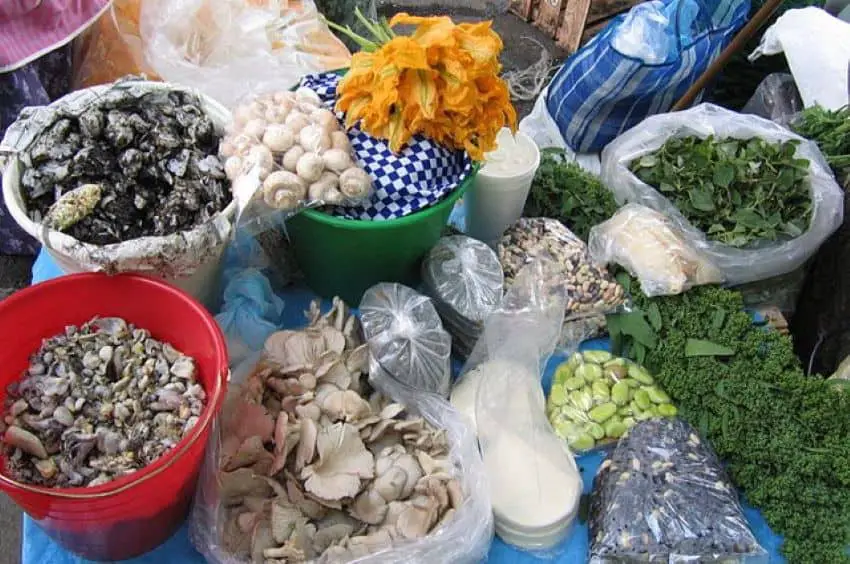A delicious dish featuring the little known huauzontle inspired me to delve deeper into this intriguing quelite, and led to a greater appreciation for the timeless wisdom of Mexican cuisine. Huauzontle, a highly nutritious pigweed native to Mexico, has been treasured since ancient times. While sharing similarities with amaranth and quinoa, huauzontle is consumed as a green and has an herbal, slightly bitter taste.
Huauzontle can be considered a superfood due to its rich nutritional profile, providing essential nutrients such as protein, fiber, calcium, iron, phosphorus and many vitamins, including A, C, E and B. Additionally, its abundant flavonoid content imparts potent antioxidant and anti-inflammatory properties, bolstering the immune system.

I was surprised to discover that the existence of huauzontle today is nothing short of a miracle, considering its tumultuous history as a forbidden food commonly mistaken for amaranth. Amaranth held a significant role as a staple food crop for the Aztecs, ranking alongside corn and beans in importance. As a tribute, Aztec farmers annually presented King Montezuma with over 20,000 tons of amaranth grain.
In addition to its nutritional value, amaranth held profound supernatural significance and played a prominent role in Aztec religious ceremonies, even those involving human sacrifices. Amaranth seeds were also mixed with honey and molded into idols of various gods, then eaten by participants after worship.
Huauzontle, visually similar to amaranth with small flower clusters, fell victim to the Spaniards’ unfamiliarity with Indigenous plants and was consequently forbidden. Hernán Cortez went so far as to threaten to personally chop off the hands of anyone found growing it. Despite its ban, huauzontle miraculously persevered due to its exceptional resilience in dry climates, even thriving in poor soils.
The delicious huauzontle dish that has become my favorite was crafted by chef Pablo Nicasio Soto. Pablo embarked on his culinary journey twelve years ago in Mexico City, working at a restaurant led by renowned chef Enrique Olvera, known for elevating street food to gourmet levels and showcasing a profound respect for the origin of each ingredient.

Growing up among his grandparents’ agricultural fields in Michoacán, Pablo gained firsthand knowledge of the milpa. This ancient Mesoamerican farming method revolves around a deep understanding of the symbiotic relationships between various plant species. Maize serves as the primary crop, interplanted with beans, squash, quelites, tomatoes, chiles and herbs to foster nitrogen fixation, promote biodiversity, enrich soil fertility and develop resistance to pests.
Pablo relocated to San Miguel de Allende seven years ago and opened the Merken Restaurant with his partner Yaya, a talented musician from Chile. Pablo noticed the scarcity of huauzontle dishes in local restaurants, and believes this is due to the labor-intensive process of removing the edible clusters from the thick stems.
Drawing inspiration from his grandmother’s delicious recipes featuring quelites from the milpa, Pablo concocted an extraordinary huauzontle dish that immediately captivated me and my friends, turning us into frequent customers. He chose chile ancho for the flavor profile because he admires its transformative journey — from fresh green poblano to dried red ancho.
When I reached out to inquire about the dish for this article, I was pleasantly surprised by the generosity of Pablo and Yaya, as they shared the full recipe for everyone to enjoy!

Chile ancho stuffed with huauzontle (3 servings)
Ingredients
- 3 ancho chiles
- 7 ounces of goat cheese
- 6 ounces of huauzontle (edible clusters only)
- 2 hoja santa leaves
- 1 white onion
- 1 clove of garlic
- 1 ounce of piloncillo
- 10 tomatoes
- 1/2 ounce of butter
While cleaning huauzontle can be a bit laborious, the effort is well rewarded. Begin by taking one branch from the bunch. Delicately pinch and slide your fingers along each slender stem to detach the edible clusters.
To ensure that the vibrant flavors and health benefits of huauzontle are preserved, Pablo recommends briefly blanching the florets in boiling salted water for only 30 seconds. He uses 20 grams of salt for every liter of water. After transferring to ice water, pat dry.
Devein the chiles and soak them in hot water with the piloncillo for approximately 3 minutes until softened.
Finely chop half an onion and one clove of garlic and sauté in a frying pan with butter.
In a bowl, mix the sauteed onion and garlic with the goat cheese and huauzontle. Stuff the chiles with this mixture.
For the sauce, sauté the 10 chopped tomatoes, half an onion and one clove of garlic. Once cooked, transfer to a blender, add the two hoja santa leaves, and puree. Strain this back into the pan and simmer over low heat for 5 minutes. Adjust the seasoning.
To serve, place half a cup of sauce on a plate, then place the stuffed chile on top and garnish with huauzontle.
As you savor each bite of this delicious dish or consider adding huauzontle to your menu, reflect on the journey that brought it to your table. Although Pablo and Yaya closed Merken to focus on their successful catering business, they remain committed to their mission of familiarizing everyone with the cherished flavors and nutritional value of ancestral superfoods.
Sandra Gancz Kahan is a Mexican writer and translator based in San Miguel de Allende who specializes in mental health and humanitarian aid. She believes in the power of language to foster compassion and understanding across cultures. She can be reached at: [email protected]
